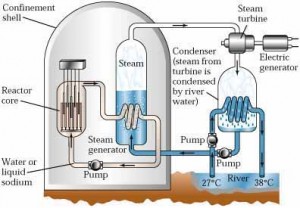Since the conception of nuclear energy as an alternative fuel source, a variety of nuclear reactor designs have been constructed. Despite their differences, most reactors have certain basic components and operating conditions as seen in the figure below.
In a traditional nuclear power plant, the fission process is just another way of producing heat. The heat produced by fission boils water to make steam used to drive a turbine, which is connected to an electric generator. The process of converting the heat energy given off by the fission reaction into electrical energy by means of the generator is essentially the same as a coal or natural-gas burning power plant.
The main source of power with traditional nuclear reactors is the reactor core. This central region contains the fuel, fuel cladding, coolant, and moderator.[4] The fuel used in nuclear reactors usually consists of elements containing fissile material along with a diluent. The main purpose of diluting agents is to act as a supporting media for the fissile material during plant operation.[4] Additionally, in traditional nuclear reactors the fissile material is enclosed in a material called cladding. The cladding is used to isolate the fuel from the coolant and minimize the chance of for radioactive particles to be released.[4]
Another key component of reactor design is the fuel source and is fact directly linked to the type of reactor being used. In the case of light water reactors (which are most common) fuel consists of uranium dioxide pellets encased in zirconium alloy cladding.[3] In the Canada Deuterium Uranium reactor natural uranium pellets are used as the primary fuel source. In the case of the a Modular Pebble Bed Reactor the fuel source is composed of uranium dioxide sphere encapsulated by carbon, silicon carbide, and graphite.[1]
A separate key design feature in nuclear power plants is the type of coolant and moderator used by the reactor. Common coolants in industry are: light and heavy water, carbon dioxide, helium, liquid sodium, liquid sodium-potassium alloy, and hydrocarbons.[3] The main purpose of the coolant is to control the reaction and transfer the thermal energy absorbed by the water to a turbine where it can be convert it to electrical energy.
One of the most important aspects of nuclear reactor design is the reactor control elements used to prevent nuclear meltdown. The most common method for controlling nuclear reactors utilizes absorbing materials such as control roads or blades.[2] In most reactors there are three different types of rods that each serve a different purpose. Safety rods are used in the start-up and shut-down process and are capable of absorbing the neutrons in the reactor thereby terminating the chain reaction.[2] Secondly, regulating rods are used to adjust the reactor’s power rate and prevent a runaway reaction. Finally, shim rods are incorporated in the design to compensate for the fuel depletion as the reaction continues.[4]
The reactor vessel itself is another key component in energy production and the overall safety of the plant. In most nuclear power designs a reactor pressure vessel is used to contain the reaction.[3] Within the vessel itself are a number of other unit operations that facilitate the nuclear reaction and keep the system under control.[3] In addition, the reactor vessel is usually housed in a containment building in order to prevent the release of radioactive material and contain a nuclear meltdown if need be.[2]
(Composed by Ivan Basurto, Edited by Becca McIver, Sean Hanczor & Dan Kervick)
References
1.Koster, A., HD Matzner, and DR Nicholsi. “PBMR Design for the Future.” Nuclear Engineering and Design 222.2-3 (2003): 231-45. Print.
2.Rowinski, Marcin Karol, Timothy John White, and Jiyun Zhao. “Small and Medium Sized Reactors (SMR): A Review of Technology.” Renewable & Sustainable Energy Reviews 44 (2015): 643-56. Print.
3.Nuclear Power Reactor . (2015 , May 3). Retrieved from World Nuclear Association : http://www.world-nuclear.org/info/Nuclear-Fuel-Cycle/Power-Reactors/Nuclear-Power-Reactors/
4.Nuclear Reactor . 17 April 2015. <http://www.britannica.com/EBchecked/topic/421763/nuclear-reactor/45789/Production-reactors#toc45790>.
